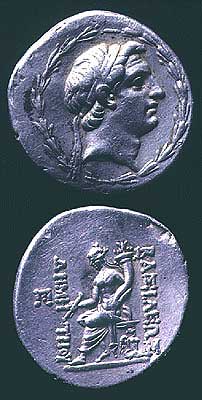Silver Tetradrachm of King Demetrios I, 162 BCE - 150 CE
Silver
C.133
Obverse: Diademed Head of the King Facing Right within Wreat Reverse: Tyche Holding Baton and Cornucopiae Seated on Throne Supported by Nereid The Seleukid Kingdom was established by Seleukos I,...
Obverse: Diademed Head of the King Facing Right within Wreat
Reverse: Tyche Holding Baton and Cornucopiae Seated on Throne Supported by Nereid
The Seleukid Kingdom was established by Seleukos I, one of the generals of Alexander the Great, following the death of Alexander and the division of his empire. At its peak under Seleukos I and Antiochus I, the Seleucid Kingdom comprised almost the whole of the conquests of Alexander with the exception of Egypt. Demetrios I was the son of Seleukos IV. He assumed power after escaping from Rome, where he was held captive for thirteen years, and disposing of his cousin Antiochus V. Later, he would be killed in battle by Alexander Balas, who avenged the death of his brother Antiochus V.
How many hands have touched a coin in your pocket or your purse? What eras and lands have the coin traversed on its journey into our possession? As we reach into our pockets to pull out some change, we rarely hesitate to think of who touched the coin before us, or where the coin will venture to after us. More than money, coins are a symbol of the state that struck them, of a specific time and place, whether currency in the age we live or an artifact of a long forgotten empire. This ancient coin is more than an artifact; it is a memorial to a lost kingdom passed from the hands of civilization to civilization, from generation to generation.
Reverse: Tyche Holding Baton and Cornucopiae Seated on Throne Supported by Nereid
The Seleukid Kingdom was established by Seleukos I, one of the generals of Alexander the Great, following the death of Alexander and the division of his empire. At its peak under Seleukos I and Antiochus I, the Seleucid Kingdom comprised almost the whole of the conquests of Alexander with the exception of Egypt. Demetrios I was the son of Seleukos IV. He assumed power after escaping from Rome, where he was held captive for thirteen years, and disposing of his cousin Antiochus V. Later, he would be killed in battle by Alexander Balas, who avenged the death of his brother Antiochus V.
How many hands have touched a coin in your pocket or your purse? What eras and lands have the coin traversed on its journey into our possession? As we reach into our pockets to pull out some change, we rarely hesitate to think of who touched the coin before us, or where the coin will venture to after us. More than money, coins are a symbol of the state that struck them, of a specific time and place, whether currency in the age we live or an artifact of a long forgotten empire. This ancient coin is more than an artifact; it is a memorial to a lost kingdom passed from the hands of civilization to civilization, from generation to generation.
Literature
V25



